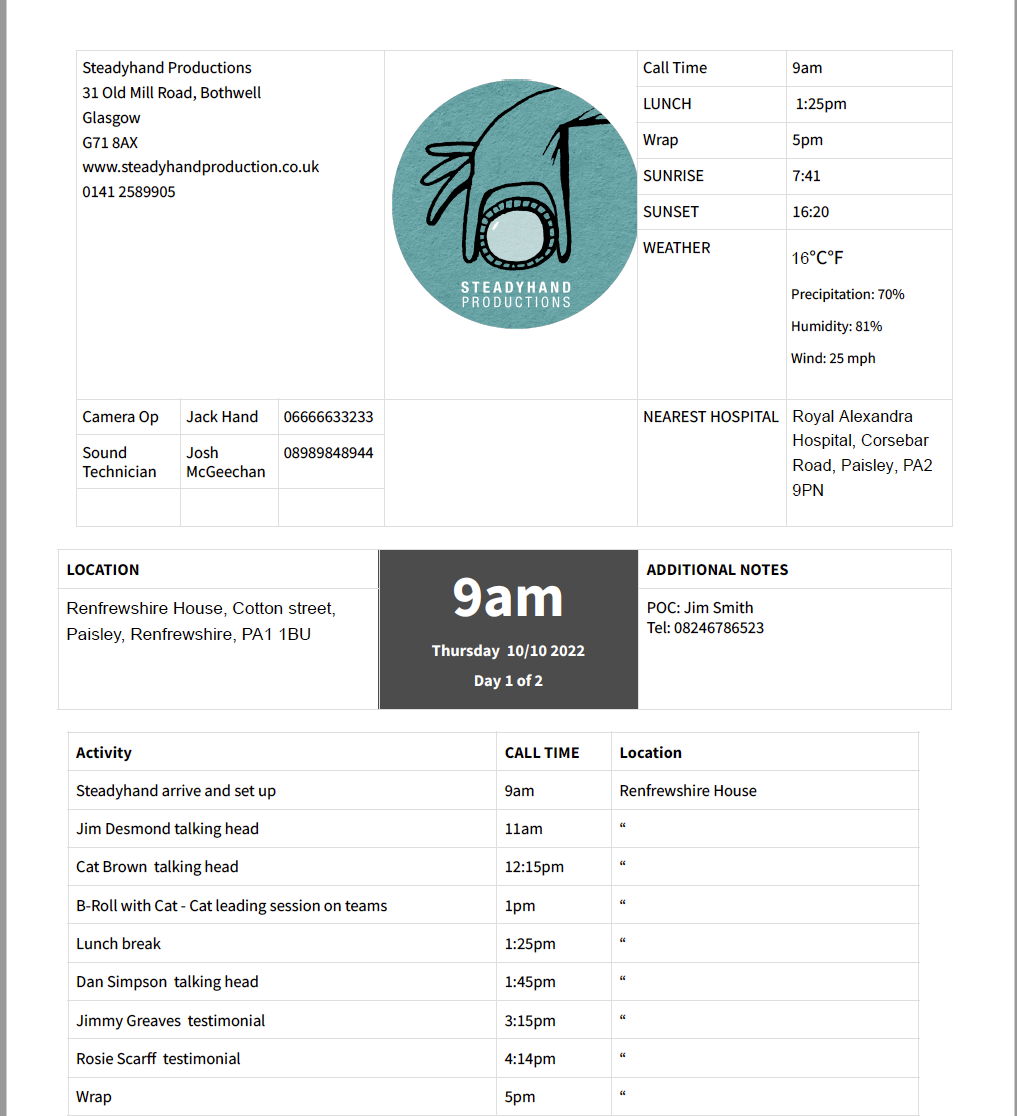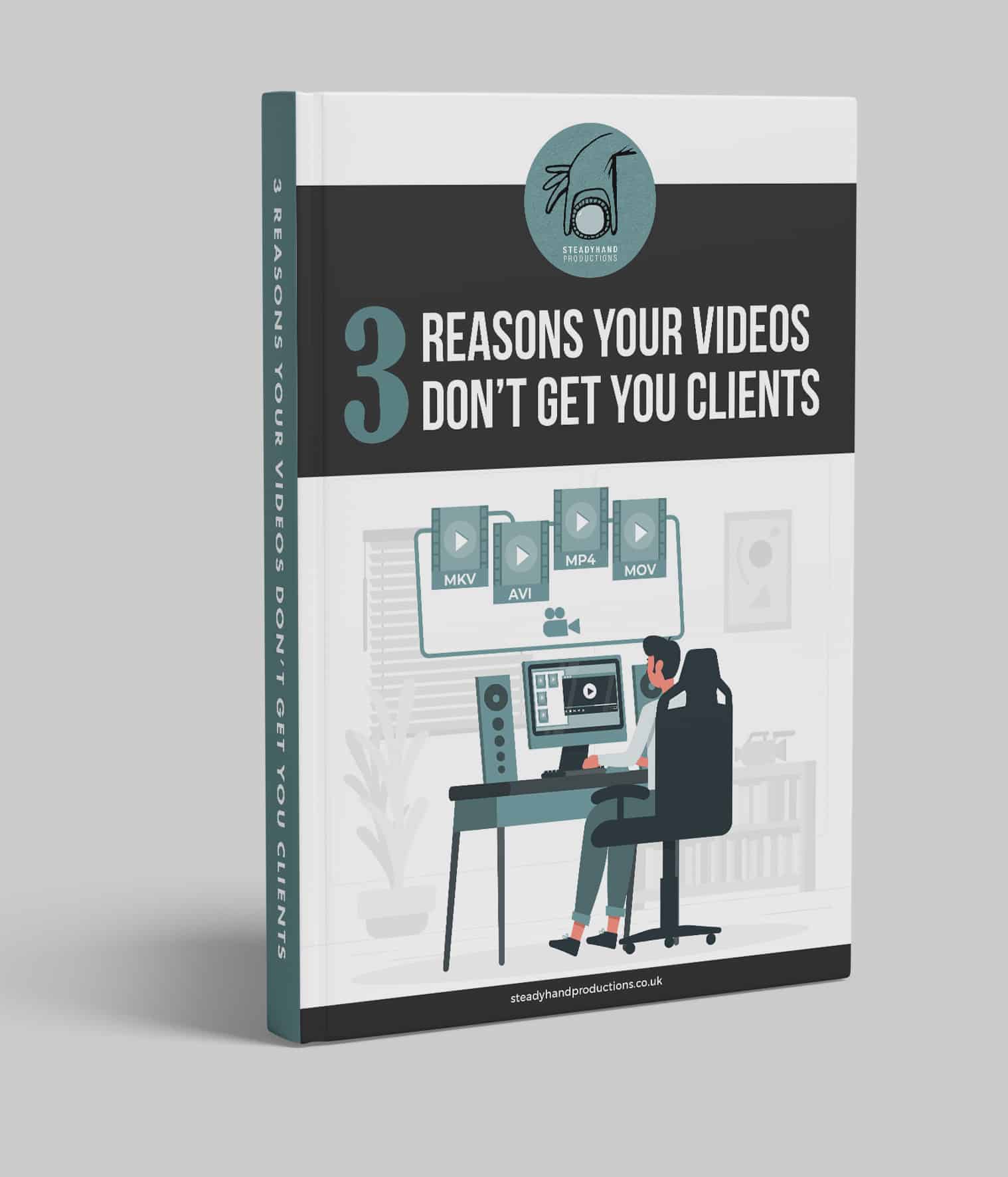You’re on your latest video production set, the crew is ready, the talent is in place, and you’re about to roll cameras. But wait, the lighting technician has yet to show up. The production grinds to a halt as you scramble to figure out where they went. This would never have happened if you had a solid call sheet.
In this ultimate guide to call sheets for video production, we’ll show you how to avoid situations like this and run a seamless, organised shoot.
We have also included our own call sheet template at the bottom of this article, which you can use in your productions.

What is a call sheet?
A call sheet is a vital production resource, providing essential information to all participating crew members.
The call sheet details the who, what and where of shooting – including shooting schedule, locations and break times – ensuring everyone knows exactly when they need to be on set.
Production coordinators or the first assistant director are typically responsible for delivering this document so that no actor or technician goes unbriefed!
A different call sheet is distributed for each day of production, which is why you often hear it called the daily call sheet. Each production day will have a different shooting schedule with varying call times and personnel.
Why is a call sheet important?
A call sheet is an indispensable tool for any video production. It’s a document that provides the entire cast and crew with essential details about when and where they will be on set, ensuring everyone knows what to expect and enabling smooth sailing throughout filming.
This way, filmmakers can maximise their time spent shooting without worrying about miscommunication between cast and crew!

What is included in a call sheet?
Making a great video requires clear and thorough communication of all the details. Call sheets are used on production sets to present this information concisely, including critical elements such as:
Production Title & Production Company:
Behind the scenes, filmmakers and crew members constantly stay busy with many projects. It may seem intuitive to label this information prominently on call sheets as a reminder for everyone involved; however, crew members can overlook even minor details without explicit attention.
Therefore, keeping production titles visible at the front and centre throughout each job is essential so everything runs smoothly. This should also include the production company’s name.
Date & Time
(First Call/General Crew Call); – Knowing the day and time of your production is crucial – not only for cast and crew attendance but also to accurately capture details for future paperwork and records.
Locations
A messy miscommunication can quickly throw a costly wrench into an otherwise productive shoot day, so ensure the crew knows exactly where to be! Keep the location(s) prominently displayed at all times; they should always appear on the call sheet.
Shooting Schedule with Scenes:
With detailed insights into scenes to be shot, meal breaks and particular actors featured each day and more – the call sheet offers an efficient summary of the shooting schedule in one comprehensive package.
Cast & crew contact info:
If any difficulties materialise, the cast and crew need to know the proper people to call. At the top of each day’s call sheet is easy-to-find contact information and phone numbers for production heads – Producers, Production Managers and Assistant Directors.
Safety information, the location of the nearest hospital:
In any situation, it’s wise to remain optimistic and ready for anything. That is why shooting crew members should always be prepared and ensure the nearest hospital information—name, address, phone number – is included on the call sheet in case of an emergency.
Parking instructions
When staging a shoot in densely populated areas like Glasgow city centre, providing parking options to cast and crew is an absolute must. After all, you don’t want delayed arrivals due to a lack of available spots! This call sheet example ensures that the vital details on where they should park are at the top so everyone can find them quickly and be ready for action on time.
Weather Forecast:
Tomorrow’s rain forecast could spell disaster for any outdoor shoots. Variables such as cloud cover, wind speed and temperature can significantly impact personnel safety and equipment reliability, not to mention how the scene would look projected onto screens nationwide!
The crew must be prepared for anything Mother Nature may have in store – after all, you don’t want them caught out in an unexpected downpour!
How to make a Call sheet
Creating the perfect call sheet doesn’t need to be a daunting task!
There are many free call sheet templates online, and we have included our call sheet template at the bottom of this blog that you can download and use in your productions.
You can compile your production’s details into one document in five simple steps.
- To get started on this process: find an online call sheet template and customise it with your project title.
- Gather any critical information regarding cast/crew contact info or scheduling times for filming.
- Edit the layout according to what will best serve each shoot – like adding break times, location specifics etc.
- Populate crew member names & responsibilities accordingly.
- Then share the completed version so everyone is well-informed about their duties come shooting day. Easy as that!
What to Avoid Including on a Call Sheet?
To ensure the privacy and confidentiality of cast, crew, businesses and secrets involved in the production process, here are some things you should not include on a call sheet.
- Personal information such as home addresses or social security numbers must remain off any paperwork connected with the shooting.
- Furthermore, confidential details like trade/business secrets must be kept under wraps – omit these from all documents related to filming too.
- Lastly, ensure contact info is only shared with those that require it; no one else needs access to this sensitive data during the pre-production stages!
By taking extra care when writing up your call sheet, you can keep everyone safe at work whilst keeping private matters exactly where they belong – away from prying eyes.
Who Receives a Call Sheet and Who Approves It
A successful shoot relies on distributing the correct call sheet to all necessary crew and cast members.
The production coordinator is responsible for compiling a detailed document that outlines important information about locations, times, scenes, and other vital set-up elements before it gets sent out.
After that point, an assistant director or director reviews the call sheet so accuracy can be secured before delivery is made confidentially to those who are part of the production––no one else!
This step in preparation ensures everyone involved with the filming knows when they should arrive and their particular roles within this project.
How to Distribute Call Sheets
Distributing call sheets is essential for keeping any video production on track. There are a few ways to share the crucial details with your team, like via email or physical copies – it all depends on factors such as crew size and preferred communication methods.
Plus, these distribution methods must be timely so everyone can access updates efficiently. No matter which way you choose, it’s essential that everybody gets their call sheet promptly!
Regarding call sheet distribution, you only have one chance and one shot at getting it right. Anything other than one call sheet per day – be they revisions or iterations of the same content or multiple days’ worth at once – is simply asking for chaos on set! So make sure everything has been carefully considered before clicking send.
Call Sheet email
Emailing Call Sheets is an easy way to get everyone on the same page. When planning production, emails are often used to quickly and conveniently relay call sheets – documents that contain all related info for everyone involved.
Be sure your message gets across in crystal clear terms; always include everything necessary with a clean-cut format so it’s easy to comprehend immediately.
Tips for Making a Call Sheet Email Effective:
Creating an effective call sheet email requires thoughtful preparation.
- Make sure all relevant production members are included as recipients,
- Provide a precise and professional subject line to ensure the reader knows what they’re getting into: An example would be the production title followed by the word “call sheet”.
- And make your content straightforward while eliminating any confusing excess details.
- Be sure to send the email in advance with the call sheet attached so everybody is well-prepared in advance of shooting day!
Additionally, to ensure everyone is on the same page, it’s imperative to follow up with team members after they’ve received their call sheet. This way, any necessary changes or other critical info will be noticed, and miscommunications will be avoided!
Free Call Sheet Template
Making a call sheet for each video production can be time-consuming and potentially chaotic – but it doesn’t have to be. To help streamline the process, we offer a free call sheet template that will not only save you valuable time but also ensure all relevant information is included in an organised manner.
Our template includes essential elements such as contact details, scheduling needs and scenes, and ensuring everyone on your team has what they need when approaching a project! Why spend hours creating different versions of the same document when our pre-made call sheet template provides everything required?
Download the call sheet template today to get started with optimally efficient videography projects without hassle.
How to Use the Call Sheet Template
- Begin by downloading the call sheet above.
- Update all relevant information, including your company name, project title and shooting dates. You may need to customise the template with additional details unique to this particular team – so go ahead and add anything you think necessary.
- Remember to save each new version of the call sheet with its file name for later reference if needed.
- Finally, distribute copies of the updated call sheet either electronically or physically – however, works best for your team members – followed by an appropriate follow-up message making sure they’ve received it in time.
Wrapping Up
Call sheets are a powerful tool to ensure the successful production of any video project.
Through customising templates and including essential details such as shooting schedules, call times, break information – even emergency contact numbers – cast and crew members can be confident that all bases have been covered for seamless execution on their set.
Whether you’re coordinating or performing in front of the camera, taking time to craft your unique call sheet carefully is an invaluable step!
Remember to download our call sheet template above to make the process quicker.





